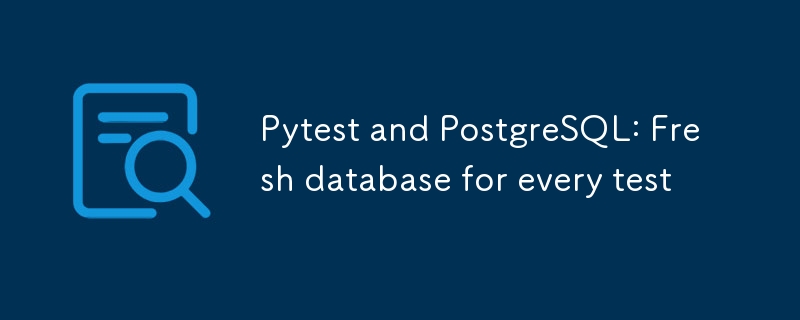

In Pytest, dem beliebtesten Python-Test-Framework aller, ist ein Fixture ein wiederverwendbarer Codeabschnitt, deretwasvor Beginn des Tests arrangiert und nach dem Beenden aufräumt. Zum Beispiel eine temporäre Datei oder einen temporären Ordner, eine Setup-Umgebung, das Starten eines Webservers usw. In diesem Beitrag schauen wir uns an, wie man ein Pytest-Fixture erstellt, das eine Testdatenbank (leer oder mit bekanntem Status) erstellt, die bereinigt wird , sodass jeder Test auf einer völlig sauberen Datenbank ausgeführt werden kann.
Die Ziele Wir werden mit Psycopg 3 ein Pytest-Gerät erstellen, um die Testdatenbank vorzubereiten und zu bereinigen. Da eine leere Datenbank zum Testen selten hilfreich ist, werden wir optional Yoyo-Migrationen anwenden (zum Zeitpunkt des Schreibens ist die Website nicht verfügbar, gehen Sie zum Snapshot von archive.org), um sie aufzufüllen. Die Anforderungen für das Pytest-Fixture namens test_db, das in diesem Blogbeitrag erstellt wurde, sind also:def test_create_admin_table(test_db): ...
def test_create_admin_table(test_db): # Open a cursor to perform database operations cur = test_db.cursor() # Pass data to fill a query placeholders and let Psycopg perform # the correct conversion (no SQL injections!) cur.execute( "INSERT INTO test (num, data) VALUES (%s, %s)", (100, "abc'def")) # Query the database and obtain data as Python objects. cur.execute("SELECT * FROM test") cur.fetchone() # will return (1, 100, "abc'def") # You can use `cur.fetchmany()`, `cur.fetchall()` to return a list # of several records, or even iterate on the cursor for record in cur: print(record)
Motivation & Alternativen
Noch eins, pytest-dbt-postgres, ich habe es überhaupt nicht versucht.
├── src │ └── tuvok │ ├── __init__.py │ └── sales │ └── new_user.py ├── tests │ ├── conftest.py │ └── sales │ └── test_new_user.py ├── requirements.txt └── yoyo.ini
├── migrations ├── 20240816_01_Yn3Ca-sales-user-user-add-last-run-table.py ├── ...
# Without DB name! TEST_DB_URL = "postgresql://localhost" TEST_DB_NAME = "test_tuvok" TEST_DB_MIGRATIONS_DIR = str(Path(__file__, "../../migrations").resolve())
Erstellen Sie test_db-Fixture
schreiben Sie das Fixture in conftest.py:
@pytest.fixture def test_db(): # autocommit=True start no transaction because CREATE/DROP DATABASE # cannot be executed in a transaction block. with psycopg.connect(TEST_DB_URL, autocommit=True) as conn: cur = conn.cursor() # create test DB, drop before cur.execute(f'DROP DATABASE IF EXISTS "{TEST_DB_NAME}" WITH (FORCE)') cur.execute(f'CREATE DATABASE "{TEST_DB_NAME}"') # Return (a new) connection to just created test DB # Unfortunately, you cannot directly change the database for an existing Psycopg connection. Once a connection is established to a specific database, it's tied to that database. with psycopg.connect(TEST_DB_URL, dbname=TEST_DB_NAME) as conn: yield conn cur.execute(f'DROP DATABASE IF EXISTS "{TEST_DB_NAME}" WITH (FORCE)')
. Schreiben Sie apply migrations als ein weiteres Fixture mit dem Namen yoyo:
@pytest.fixture def yoyo(): # Yoyo expect `driver://user:pass@host:port/database_name?param=value`. # In passed URL we need to url = ( urlparse(TEST_DB_URL) . # 1) Change driver (schema part) with `postgresql+psycopg` to use # psycopg 3 (not 2 which is `postgresql+psycopg2`) _replace(scheme="postgresql+psycopg") . # 2) Change database to test db (in which migrations will apply) _replace(path=TEST_DB_NAME) .geturl() ) backend = get_backend(url) migrations = read_migrations(TEST_DB_MIGRATIONS_DIR) if len(migrations) == 0: raise ValueError(f"No Yoyo migrations found in '{TEST_DB_MIGRATIONS_DIR}'") with backend.lock(): backend.apply_migrations(backend.to_apply(migrations))
, benötigen Sie Yoyo Fixture für test_db Fixture:
@pytest.fixture def test_db(yoyo): ...
, erfordern Sie Yoyo einzeln:
def test_create_admin_table(test_db, yoyo): ...
Ich hoffe, dieser Artikel hat Ihnen bei Ihrer eigenen Datenbank-Testsuite geholfen. Hinterlassen Sie mir Ihre Frage gerne in den Kommentaren und viel Spaß beim Codieren!
Das obige ist der detaillierte Inhalt vonPytest und PostgreSQL: Frische Datenbank für jeden Test. Für weitere Informationen folgen Sie bitte anderen verwandten Artikeln auf der PHP chinesischen Website!




